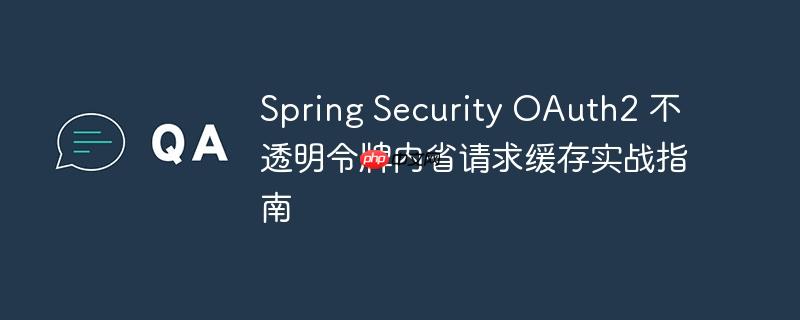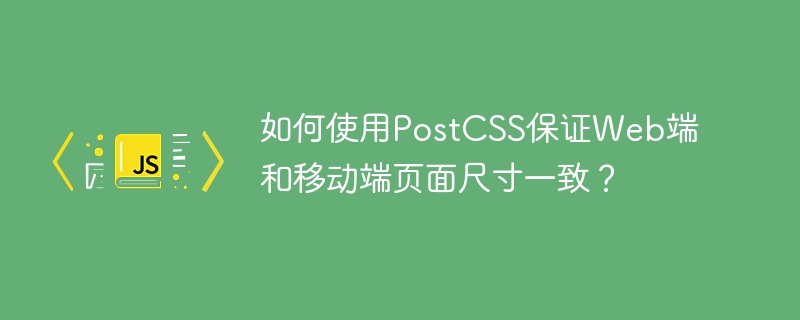
本文旨在提供一个在spring Security中缓存OAuth2不透明令牌内省请求的实用教程。当认证服务器不稳定时,通过自定义OpaqueTokenIntrospector并集成Ehcache等缓存机制,可以有效减少对认证服务器的请求次数,从而提高资源服务器的稳定性和响应速度,避免因内省失败导致的401错误。
1. 背景与挑战
在使用spring security构建oauth2资源服务器时,如果采用不透明令牌(opaque token)模式,资源服务器需要通过内省(introspection)机制向认证服务器验证接收到的令牌。这意味着每次请求到达资源服务器时,都会触发一次对认证服务器的内省调用。当认证服务器不稳定或响应缓慢时,这可能导致资源服务器性能下降,甚至因内省失败而频繁返回401未授权错误,严重影响用户体验。为了解决这一问题,引入缓存机制来存储已验证的令牌内省结果变得至关重要。
2. spring security OAuth2 不透明令牌内省机制
Spring Security 5.x 提供了对OAuth2资源服务器的支持,其中不透明令牌的内省通过OpaqueTokenIntrospector接口实现。默认情况下,Spring Security会使用NimbusOpaqueTokenIntrospector,它直接通过http请求与认证服务器的内省端点进行通信。
标准的Spring Security配置如下:
@Configuration @EnableWebSecurity public class SecurityConfig extends WebSecurityConfigurerAdapter { @Value("${spring.security.oauth2.resourceserver.opaque-token.client-id}") private String clientId; @Value("${spring.security.oauth2.resourceserver.opaque-token.client-secret}") private String clientSecret; @Value("${spring.security.oauth2.resourceserver.opaque-token.introspection-uri}") private String introspectionUri; @Override protected void configure(HttpSecurity http) throws Exception { http .authorizeRequests(authorizeRequests -> authorizeRequests .anyRequest().authenticated() ) .oauth2ResourceServer(oauth2ResourceServer -> oauth2ResourceServer .opaqueToken(opaqueToken -> opaqueToken .introspectionClientCredentials(this.clientId, this.clientSecret) .introspectionUri(this.introspectionUri) ) ); } }
要引入缓存,我们需要替换或包装默认的OpaqueTokenIntrospector实现。
3. 实现自定义缓存型OpaqueTokenIntrospector
本节将展示如何创建一个自定义的OpaqueTokenIntrospector,利用Ehcache作为缓存解决方案,以存储和管理已内省的令牌。
3.1 定义自定义内省器
首先,创建一个名为CustomOpaqueTokenIntrospector的类,它将实现OpaqueTokenIntrospector接口,并封装一个底层的NimbusOpaqueTokenIntrospector实例。
import org.ehcache.Cache; import org.ehcache.CacheManager; import org.ehcache.config.builders.CacheConfigurationBuilder; import org.ehcache.config.builders.CacheManagerBuilder; import org.ehcache.config.builders.ResourcePoolsBuilder; import org.ehcache.expiry.ExpiryPolicyBuilder; import org.springframework.security.oauth2.core.OAuth2AuthenticatedPrincipal; import org.springframework.security.oauth2.server.resource.introspection.NimbusOpaqueTokenIntrospector; import org.springframework.security.oauth2.server.resource.introspection.OpaqueTokenIntrospector; import java.time.Duration; import java.time.Instant; public class CustomOpaqueTokenIntrospector implements OpaqueTokenIntrospector { private final OpaqueTokenIntrospector delegateIntrospector; // 委托给实际的内省器 private final CacheManager cacheManager; private final Cache<String, OAuth2AuthenticatedPrincipal> AccessTokensCache; public CustomOpaqueTokenIntrospector(String uri, String clientId, String clientSecret) { // 1. 初始化Ehcache缓存管理器 this.cacheManager = CacheManagerBuilder.newCacheManagerBuilder().build(); this.cacheManager.init(); // 2. 配置并创建缓存实例 // 缓存名称为"iamCache",键为String(token),值为OAuth2AuthenticatedPrincipal // 堆内存大小限制为1000个条目,过期策略为TTL(time-to-live)1800秒(30分钟) this.accessTokensCache = cacheManager.createCache("iamCache", CacheConfigurationBuilder .newCacheConfigurationBuilder(String.class, OAuth2AuthenticatedPrincipal.class, ResourcePoolsBuilder.heap(1000)) .withExpiry(ExpiryPolicyBuilder.timeToLiveExpiration(Duration.ofSeconds(1800)))); // 3. 初始化委托的内省器,这里使用NimbusOpaqueTokenIntrospector this.delegateIntrospector = new NimbusOpaqueTokenIntrospector(uri, clientId, clientSecret); } @Override public OAuth2AuthenticatedPrincipal introspect(String token) { // 1. 尝试从缓存中获取令牌对应的认证主体 OAuth2AuthenticatedPrincipal principal = accessTokensCache.get(token); if (principal != null) { // 2. 如果缓存中存在,检查其过期时间("exp"属性) // 注意:这里假设OAuth2AuthenticatedPrincipal中包含"exp"属性, // 且其类型为Instant。实际应用中需根据认证服务器返回的内省结果调整。 Instant expirationTime = principal.getAttribute("exp"); if (expirationTime != null && expirationTime.isAfter(Instant.now())) { // 3. 如果未过期,直接返回缓存中的认证主体 return principal; } else { // 4. 如果已过期,从缓存中移除 accessTokensCache.remove(token); } } // 5. 如果缓存中不存在或已过期,调用委托的内省器进行实际的内省请求 principal = delegateIntrospector.introspect(token); // 6. 将新的认证主体存入缓存 accessTokensCache.put(token, principal); return principal; } /** * 提供一个方法用于获取缓存实例,尽管在实际生产代码中可能不需要直接暴露。 * @return 缓存实例 */ public Cache<String, OAuth2AuthenticatedPrincipal> getAccessTokensCache() { return accessTokensCache; } /** * 在应用程序关闭时,需要关闭CacheManager以释放资源。 * 可以在Spring的@PreDestroy方法中调用此方法。 */ public void closeCacheManager() { if (cacheManager != null && cacheManager.getStatus() == org.ehcache.Status.AVaiLABLE) { cacheManager.close(); } } }
代码解析:
- 构造函数:
- 初始化CacheManager,它是Ehcache管理缓存的入口。
- 通过CacheConfigurationBuilder配置并创建了一个名为iamCache的缓存。
- ResourcePoolsBuilder.heap(1000):指定缓存最大在堆内存中存储1000个条目。
- withExpiry(ExpiryPolicyBuilder.timeToLiveExpiration(Duration.ofSeconds(1800))):设置缓存条目的存活时间(TTL)为1800秒(30分钟)。这意味着一个条目在被添加到缓存后,最多存活30分钟。
- 初始化delegateIntrospector,它是一个NimbusOpaqueTokenIntrospector实例,负责实际的远程内省调用。
- introspect(String token)方法:
- 首先尝试从accessTokensCache中获取与token对应的OAuth2AuthenticatedPrincipal。
- 如果找到,会检查其exp(过期时间)属性。如果exp存在且晚于当前时间,则认为令牌仍然有效,直接返回缓存中的principal。
- 如果令牌已过期或在缓存中未找到,则调用delegateIntrospector.introspect(token)进行远程内省。
- 内省成功后,将新的principal存入缓存,并返回。
3.2 将自定义内省器注册为Spring Bean
为了让Spring Security使用我们自定义的CustomOpaqueTokenIntrospector,我们需要在安全配置类中将其暴露为一个@Bean。
import org.springframework.context.annotation.Bean; import org.springframework.context.annotation.Configuration; import org.springframework.security.config.annotation.web.builders.HttpSecurity; import org.springframework.security.config.annotation.web.configuration.EnableWebSecurity; import org.springframework.security.config.annotation.web.configuration.WebSecurityConfigurerAdapter; import org.springframework.security.oauth2.server.resource.introspection.OpaqueTokenIntrospector; import org.springframework.beans.factory.annotation.Value; import javax.annotation.PreDestroy; // 引入PreDestroy注解 @Configuration @EnableWebSecurity public class SecurityConfig extends WebSecurityConfigurerAdapter { @Value("${spring.security.oauth2.resourceserver.opaque-token.client-id}") private String clientId; @Value("${spring.security.oauth2.resourceserver.opaque-token.client-secret}") private String clientSecret; @Value("${spring.security.oauth2.resourceserver.opaque-token.introspection-uri}") private String introspectionUri; private CustomOpaqueTokenIntrospector customIntrospector; // 声明实例 @Bean public OpaqueTokenIntrospector introspector() { // 创建并返回自定义的OpaqueTokenIntrospector实例 this.customIntrospector = new CustomOpaqueTokenIntrospector(this.introspectionUri, this.clientId, this.clientSecret); return this.customIntrospector; } @Override protected void configure(HttpSecurity http) throws Exception { http .authorizeRequests(authorizeRequests -> authorizeRequests .anyRequest().authenticated() ) .oauth2ResourceServer(oauth2ResourceServer -> oauth2ResourceServer .opaqueToken(opaqueToken -> // 将自定义的introspector Bean注入到Spring Security配置中 opaqueToken.introspector(introspector()) ) ); } // 在Bean销毁前关闭Ehcache CacheManager @PreDestroy public void destroy() { if (customIntrospector != null) { customIntrospector.closeCacheManager(); } } }
配置解析:
- @Bean public OpaqueTokenIntrospector introspector():这个方法创建并返回CustomOpaqueTokenIntrospector的实例。Spring Security会自动检测到这个Bean,并将其用于不透明令牌的内省。
- opaqueToken.introspector(introspector()):明确告诉Spring Security使用我们提供的OpaqueTokenIntrospector Bean。
- @PreDestroy:在spring容器销毁SecurityConfig Bean之前,调用closeCacheManager()方法,确保Ehcache资源得到正确释放,防止内存泄漏。
4. 注意事项与最佳实践
- 依赖管理: 确保项目中已引入Ehcache的maven或gradle依赖:
<!-- Maven --> <dependency> <groupId>org.ehcache</groupId> <artifactId>ehcache</artifactId> <version>3.10.8</version> <!-- 使用最新稳定版本 --> </dependency> <dependency> <groupId>javax.xml.bind</groupId> <artifactId>jaxb-api</artifactId> <version>2.3.1</version> <!-- Java 9+ 可能需要 --> </dependency>
- 缓存过期策略:
- TTL (Time To Live): 从创建或最后一次更新开始计算的存活时间。
- TTI (Time To Idle): 从最后一次访问开始计算的空闲时间。
- 选择合适的过期策略至关重要。通常,令牌的缓存过期时间应小于或等于令牌本身的实际过期时间,并考虑认证服务器的令牌刷新机制。本例中使用的是TTL。
- 缓存容量与驱逐策略:
- ResourcePoolsBuilder.heap(1000):设置堆内存中缓存的最大条目数。当达到此限制时,Ehcache会根据配置的驱逐策略(如LRU、LFU等,默认通常是LRU)移除旧条目。
- 生产环境中,应根据实际流量和内存情况调整缓存容量。
- 分布式缓存:
- 上述示例使用的是本地Ehcache,适用于单实例应用。
- 如果应用部署在多个实例上,每个实例都会有自己的本地缓存,可能导致不同实例间数据不一致。
- 对于分布式环境,应考虑使用redis、Hazelcast等分布式缓存解决方案,并结合Spring Cache Abstraction进行更高级的抽象和管理。
- 安全性: 缓存的令牌内省结果可能包含敏感信息。确保缓存存储在安全的环境中,并遵循最小权限原则。
- 错误处理: 在introspect方法中,当delegateIntrospector.introspect(token)失败时(例如,认证服务器不可达),应考虑如何处理这些异常。是直接抛出异常,还是返回一个特定的错误主体,或者尝试重试?这取决于具体的业务需求和弹性策略。
- Spring Cache Abstraction: 对于更通用的缓存需求,可以考虑使用Spring的@Cacheable、@CacheEvict等注解,并配置一个自定义的CacheManager。然而,对于OpaqueTokenIntrospector这种特定接口的包装,直接实现接口可能更直接。
5. 总结
通过自定义OpaqueTokenIntrospector并集成Ehcache,我们成功地为Spring Security OAuth2不透明令牌的内省请求引入了缓存机制。这不仅能有效减轻认证服务器的压力,提高资源服务器的性能和稳定性,还能在认证服务器暂时不可用时提供一定的容错能力。在实际部署时,务必根据应用场景和性能需求,合理配置缓存策略,并考虑分布式环境下的缓存解决方案。


















